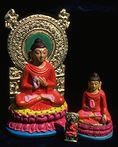|
|
Buddha Amitaba Symbol of Self-Realization. The teachings of Buddha (b. circa 525 BCE) developed in India as a reformative outgrowth of Hinduism and provide an extensive cosmological picture, a basis for ethical behavior and a self-empowering philosophy of life. Rupas (statues) of the Buddha and of his innumerable incarnations, called bodhisattvas, serve to focus a meditator's inward devotional practice. The statues' vivid colors, intricacy and symmetry are also a source of delight to collectors of Eastern art. Buddha is portrayed in classic lotus pose, lost in meditation as he sat beneath the Bodhi tree and achieved ultimate realization. This he delineated as the Law of the Wheel: 1) Life is suffering; 2) Suffering's cause is desire; 3) Elimination of desire brings an end to suffering; 4) This state of nirvana can be achieved by following the Eightfold Path of right living. |
|||||
|
Item Code
Size (usually inches)
Price
B10
10
$36
|
